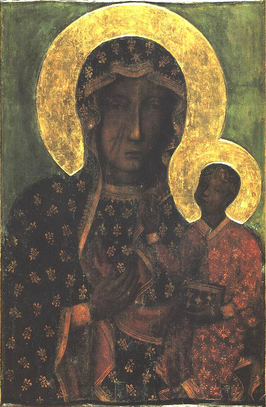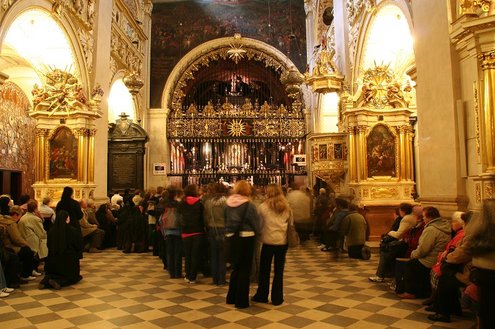|
Twice yesterday I ran into The Black Madonna. HA, not literally “ran into”, but I like that opening statement. The heroine of my WIP is a Polish Catholic, and I’m tapping into my heritage and history to write it. But yesterday, serendipitously, I learned some new #HistoryWithHeart. While I was researching St. Kazimierz, I came across a reference to Our Lady of Czestochowa (which I just spelled correctly on my first try, thankyouverymuch), and then, not two hours later, I found a small medallion with her image on it. I thought that was a neat coincidence, and thought to do a little write-up on her. Photo of original icon and a copy made with clearer features. Both from Wikipedia. Years ago, I was lucky enough to visit the Jasna Góra Monastery in Czestochowa, Poland, where the icon called The Black Madonna resides. Looking at this photo, you can see why she’s called that; supposedly centuries of candle soot has turned the figures’ skin black (although I’m not so sure they weren’t black to begin with). This icon is said to have been painted by St. Luke the Evangelist himself (on the planks of the Holy Family’s dining room table, no less) while he spoke to the Virgin Mary about her experiences for his gospel. Legend states it was brought to Constantinople from Jerusalem in 326 CE by St. Helena, where it resided for centuries before being brought to Poland. Art historians claim that it’s not quite that old; probably painted sometime in the sixth century, but agree that it came to Poland from what is now Hungary (they also think that the fleur-de-lis on Mary’s clothes were added later, by one of the kinds of Hungary with French connections). The miracles associated with the painting are both public and private. In 1382 and then again in 1430 the painting’s home was attacked by enemy looters. The Black Madonna received an arrow in the throat and two sword slashes across her right cheek. It’s said that the man holding the sword fell to the ground in agony, which scared the enemy away. Similarly, in 1655, she’s credited with allowing a force of 250 monks and locals to hold off the invading Swedes (approximately 4000 strong) for well over a month. Pilgrims at Jasna Gora Monastery's shrine to The Black Madonna. From big-world-out-there.com Pilgrimages to the shrine have been popular for centuries. When the Russians were closing in on Warsaw in 1920, thousands of devout Catholics made the traditional 9-day pilgrimage to Czestochowa to pray for the city’s safety… the Poles then defeated the Russians at the Battle of Warsaw. And throughout Nazi occupation (and later during the Communist rule), Catholics still made the pilgrimage at great personal risk to themselves. The man who would later become Pope Saint John Paul II made the secret pilgrimage from his home near Krakow to pray before The Black Madonna during Nazi occupation.
When I visited Our Lady of Czestochowa, I wasn’t on a pilgrimage, but just studying the art and architecture of Catholicism (and Judaism too, actually) in Poland. But I had enough respect to cover my hair and sit contemplatively in her presence. No matter your faith, it’s hard not to respect the centuries of devout prayer that wraps around the painting. And it’s impossible not to imagine the thousands—hundreds of thousands—of humans who’ve knelt in that same spot and prayed for miracles and intercession. It’s a humbling experience. Belief is a powerful force, and in Jasna Góra, it’s tangible.
3 Comments
|
Historical Romance is
|


 RSS Feed
RSS Feed





